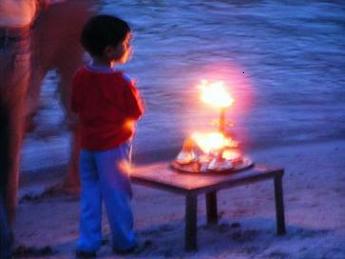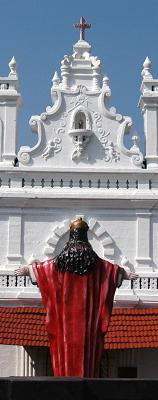|
|
An Overview of Indian Religion
History, Ideals and Practices of India's Major Religions

| Indian religion plays an intrinsic part in daily life and culture. It influenes the food that is eaten, the music that is played, the way people dress and how they view the world. It is both silently observed or ecstatically celebrated, and is as varied as it is ingrained. Religious traditions, beliefs and behaviours commonly seen in India are often thousands of years old, passed down and altered throughout the years, with influences picked up along the way. |
Symbols of faith can be noticed in millions of households, street corners and temples around India. It is seen in the henna patterns on a young woman's hands or heard in the morning with a call to prayer. Faith is observed at countless shrines, mosques and churches as well as at riversides, by the sea and in the mountains. Its influence has been woven into architecture and
India's festivals
as well as being significant to India's ideals and politics. Indian religion can certainly cause conflict amongst its people, especially when combined with politics, but for the most part a person's faith is respected here whatever the form. Sometimes a visitor to India will be asked what is their faith, and the only answer that seems to confuse is that a person 'has no faith / belief in God.' Indian religion is a way of life, and encompasses much of an individuals spirituality and ideals. To many Indian people, a denial of faith must appear to be a denial of spirituality or ideals.
Below is an overview of the major beliefs defining Indian religion. Many beliefs are flavoured by local custom, mythology and influences, so these descriptions provide a broad rather than intricate insight. Part of the appeal of India is observing everywhere for yourself the intricacies of religion, faith and tradition.
Hinduism

| Hinduism is the most widely observed Indian religion and accounts for about 81% of the population's beliefs. Though the beliefs of this majority come under the bracket of Hinduism, the Indian religion itself is a little like a fractal pattern with its ancient Vedic roots spreading out towards countless avenues of expression. Part of the problem in defining Hinduism is that it incorporates a myriad of schools, sects and local traditions. The term Hinduism was in fact introduced by the English to refer to all religious beliefs native to India. Hinduism as an Indian religion has no specific founder and is referred to in Sanskrit as Sanâtana Dharma, the eternal law. Its sacred texts date from 1500 BC, the most significant of these being the the Vedas and the Upanishads. Other sacred texts include the Purâṇas, the Mahâbhârata and Râmâyaṇa and the Bhagavad Gîtâ. Common themes of Hinduism include Samsâra, Karma and Moksha which cover the cycle of birth and death, the consequence of actions and the resulting possibility of escape from suffering. These beliefs form the concept of reincarnation as a journey of the spirit towrds eternal salvation. 'Moksha,' or salvation from suffering and the cycle of reincarnation, is aspired to by all practising Hindus. It can be achieved or moved closer to by following certain paths and disciplines, the key of which is atma-jnana, or self-realization. Many rituals and practices of Hinduism are incorporated into daily life. They serve as a reminder of the divine, and encourage the journey towards awareness of God and the self. These include pûjâ, or prayer, which is performed in temples, in the home or in a holy place. This often involves giving offerings such as sweets, insence, flowers or candles. Purification by bathing is another common ritual, and will often take place on ghats (steps) leading down to a river such as in the pilgramage city of Varanasi or at a temple tank. |
| Hindu temples are often ascribed to various deities and all of these represent the many aspects and manifestations of the Supreme Being, sometimes referred to as Brahman, but generally felt to be the Ultimate Truth. Cities, states, households and individuals often associate with a few chosen deities, though occasions such as marriages, starting a new school, journeys, births, deaths and festivals may invoke a particular deity. Deities can be seen all over India, in shrines at the roadside, in temples, on postcards, paintings, as statuettes in the home and symbols adorning the bodies of their followers, making this largest Indian religion always apparent. There are millions of Hindu gods and goddesses if you consider regional deities, and some of the most well known include: Vishnu, Brahma, Shiva, Laskshmi, Parvarti, Krishna, Ganesha, Durga, Hanuman, Kali and Rama. |
Islam

| Though not an Indian religion, Islam is the second largest religion of India, with its devotees totalling about 13% of the population. The Muslim population in India is the third largest in the world. Islam centres around the Qur'an, a religious text that is believed to have been offered by the angel Jibrīl, or Gabriel, to the Prophet Muhammed in the 7th century AD. It is considered by Muslims to be the direct word of Allāh, the One God. Central to the Muslim belief are the Five Pillars of Islam. Though slight variations occur within different pathways of Islam, the largest group, the Sunni Islam, aspire to the following practices:
Shahadah is the beflief in the One God being the only God worthy of worship, and that Muhammad is the messenger of God. This creed must be repeated in prayer.
Salah is ritual prayer, repeated five times a day facing the direction of Mecca, and instigated in Muslim areas by a call to prayer.
Zakat is the giving of alms to the poor and to the financial costs included in the spread if Islam.
Sawm is fasting during the month of Ramadan, where food and drink are not to be consumed during the daylight hours.
Hajj is the pilgrimage to Mecca which must be udertaken a least once in the lifetime of every able bodied and financially capable Muslim. Islamic influence was first felt in India in the 7th Century by the arrival of Arab traders to the Malabar region of what is now northern Kerala. |
During the 8th Century AD Islam spread into modern day Pakistan, and the aquisition of the Punjab by the 10th Century AD into the Ghaznavid Empire ensured Islam a foothold in Northern India. In the late 12th Century Muhammad of Ghor increased his Ghorid Empire further into northern India, eventually securing Delhi. This paved the way for the Delhi Sultanate which from 1206 to 1526 held a fluctuating grasp on the subcontinent of India. Islamic rule in India was continued as a result of the spread of the Persian Mughal Empire into North India. This signified the end of the Delhi Sutanate and ensured that the Mughal Dynasty was the dominant power in the Indian subcontinent until the 18th century AD. It was during the Mughal Dynasty that much of India's Islamic architecture was constructed, including the famous Taj Mahal in the 1600s and the Jama Masjid in New Delhi. North India's architecure and art remains heavily influenced by this period. After British rule and subsequent independence in 1947, Muslims and Hindus in India have struggled for a peaceful approach to relations between the two faiths.
Christianity

| Comprising of around 2.4% of Indian religion, Christianity is especially prevalent in the southern states of Goa and Kerala as well as other regions in the south, and in some of the northern states. Christianity centres around the life and teachings of Jesus Christ, believed to be the Messiah of the Hebrew Bible, and the direct son of God. His death and resurrection form the cornerstone of the Christian religion and represent the possibity of salvation and eternal life achievable by the faithful. Christian tradition credits Saint Thomas with the introduction of Christianity to Indian religion in AD52, though strong trade routes between India and Central Asia, the Middle East and the Mediterranean area certainly had an influence on the spread of Christianity. French and Portuguese missionaries shaped the spread of Christianity in India thoughout the 14th, 15th and 16th centuries AD, and Goa in particular remains heavily influenced by the the Portuguese, with around 30% of its population being Roman Catholic. White washed churches and cathedrals are a common sight in Goa and shrines depicting Jesus or the Virgin Mary appear in many houses, shops and cafes. Today many Christians in India are involved in providing hospitals, poverty relief and educational services throughout the country. |
Sikhism
Making up nearly 2 percent of the religious faiths represented in India, the Sikh population here are centred around the Punjab region of north-east India. Here, 60% of the population are Sikh, and the state is home to the Golden Temple in Amritsar, which is considered the holiest of Sikh shrines. The Indian religion of Sikhism is based upon the teachings of Guru Nanak, 1469-1539, and ten successive Gurus, all of whom are considered divine. The interpretation of God is non-anthropomorphic, without form, omnipresent and infinite. Sikh people aspire to attain salvation in the form of a spiritual union with God, thus to the Universe. Māyā is the human illusion of reality, which equates satisfaction with wordly pleasures resulting in attatchment, greed and anger. This is believed to separate a person from the divine, and tie them to a cycle of death and rebirth (reincarnation). Sikhs strive through meditation and repetition of the name of God to move towards God. Important to Sikh philosophy is a lack of discrimination against gender, caste (in India) and creed, and the benefit of living a charitable and noble existence. Sikh people do not generally seek to convert, nor do they worship idols. Baptised Sikhs are bound to carry five representations of their faith and ideals - uncut hair, a small comb, a bracelet, dagger and special undergarment.
Buddhism
| The Indian religion of Buddhism is based on the teachings of Siddhartha Gautama, known commonly as Buddha or The Awakened One, who lived between the 6th and 4th centuries BC in north-east India. The conventional narrative of Siddhartha Gautama's life is that his father, King Śuddhodana, was visited by an astrologer after the prince's birth. The astrologer predicted that Siddhartha would either abandon the material world and become a holy man, or live to be a great king, depending on whether he experienced life outside the palace walls. Despite Śuddhodana's efforts to prevent his son from leaving the palace, Siddhartha began to venture out of the grounds in his 29th year. There he witnessed what Buddhist literature refers to as 'the four sights,' an old man, a sick man and a dead man, who showed him the suffering of man, and a holy man who was at peace with the world. These experiences prompted Siddhartha to one day leave his royal home in the palace and follow a spiritual path. Siddhartha sought to free himself from the cycle of suffering and re-birth (Samsara) and become an awakened being. After experiencing the prolonged fasting and pain associated with an extreme ascetic life, he discovered the Middle Way, a path between indulgence of the self and destruction of the self. At 35, Siddhartha Guatama sat in meditation under a Bodhi tree in the sacred town of Bodh Gaya, India, and arose awake to the nature of reality as The Enlightened One. His path from then was one of teaching, attracting followers into his monastic order. Today the Indian religion of Buddhism has grown to be the fourth largest religion in the world, with devotees following various paths to spiritual enlightenment or peace within the self. |
Jainism
The ancient India religion of Jainism is believed by many to predate Hinduism and has 10.2 million followers in India. Jainism follows the teachings of 24 Tirthankaras, 'those who have discovered and shown the way to salvation'. It prescribes a philosophy of non-violence to every living being, and a progression of the soul towards divine consciousness through self-control and wisdom. Jain monks and nuns follow a strict code, aiming to make this current incarnation their last, and therefore practice non-violence, truth, not stealing, celibacy and non-attachment to materialistic things. Common men and women of the Jain faith follow these rules to a lesser extent in that sex is confined to marriage, and believers are also vegetarians (non-violence). Root vegetables are also avoided due to their being grown underground and therefore containing high levels of bacteria, i.e. life. Despite representing less than 1% of Indian religion, Jainism has a prominent influence on Indian culture through its temples, literature, education and cuisine.
Indian religion in an everyday part of Indian life, and is celebrated in numerous festivals throughout the country.
More useful and entertaining facts about India...
^TOP^
Click here to leave Indian Religion and return to Travel India Goa Guide Home
Indian Festivals -
Facts About India -
India Air Travel -
Gallery -
Getting Around India -
Visas

|
|
|










